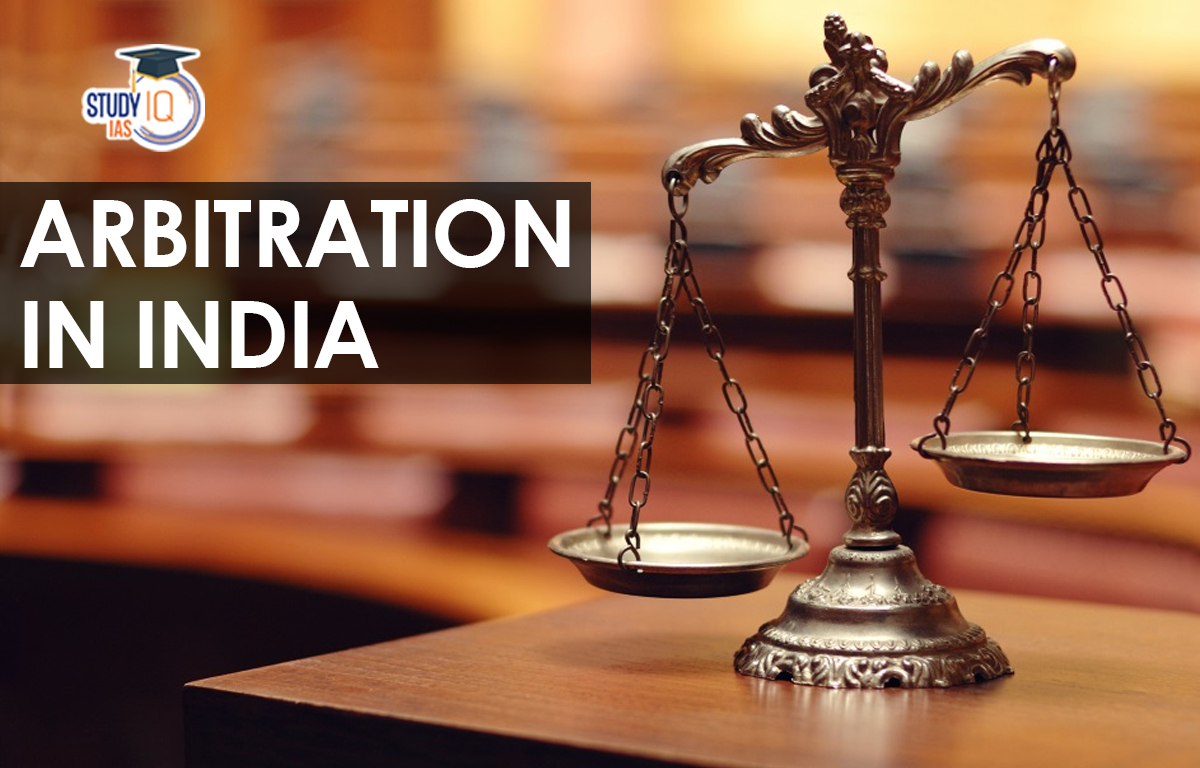Table of Contents
Context: At the recently concluded Delhi Arbitration Weekend, the Union Law minister emphasised the need for institutional arbitration to enhance the ease of doing business in India.
What is Arbitration?
- Arbitration is a form of alternative dispute resolution (ADR) where parties to a dispute agree to resolve their differences outside of a court system.
- In arbitration, a neutral third party, called an arbitrator, is appointed to hear the evidence presented by both parties and make a binding decision that resolves the dispute.
- Benefits of arbitration:
- Minimizes court intervention: Arbitration provides a more private and less formal setting for dispute resolution.
- Cost-effective: Litigating a dispute in court can be expensive, whereas arbitration can be a much more cost-effective, as parties have more control over the process.
- Speed: There are well-defined time limits for passing awards, resulting in quick disposal of the matter.
- Fairness: Arbitrators are usually appointed by both parties to the agreement, resulting in a fair selection of the arbitrator.
- Awards passed are final in nature: Once an award is passed, it is binding and enforceable, which can bring a finality to the dispute resolution process.
- Specialization: Parties can choose an arbitrator skilled in the law they are facing disputes over, which can lead to more informed and specialized decision-making.
- Confidentiality: Arbitration proceedings are confidential, which can help protect the privacy of the parties involved and keep sensitive business information confidential.

Mechanism for Arbitration in India
- Arbitration in India is regulated by the Arbitration and Conciliation Act, 1996.
- The Act is based on the 1985 UNCITRAL (The United Nations Commission on International Trade Law) Model Law on International Commercial Arbitration and the UNCITRAL Arbitration Rules 1976.
- In 2015, Arbitration and Conciliation (Amendment) Act was enacted to improve the arbitration in India.
- The 2015 amendments tried to ensure quick enforcement of contracts, easy recovery of monetary claims, reduce the pendency of cases in courts and hasten the process of dispute resolution through arbitration.
- New Delhi International Arbitration Centre (NDIAC): It was setup in 2019 under the provisions of the NDIAC Act, 2019 for better management of arbitration in India.
- It promotes institutional arbitration and provide world-class infrastructure for arbitration proceedings.
- International Centre for Alternative Dispute Resolution (ICADR) was established in 1995 for the promotion and development of ADR facilities and techniques to facilitate early resolution of disputes and to reduce the increasing burden of arrears in Courts.
What are the Types of Arbitration in India?
- There are two types of arbitration in India: Ad-hoc arbitration and Institutional arbitration.
Ad-hoc Arbitration
- It is a process where a tribunal conducts arbitration using either pre-agreed rules or tribunal-laid rules, in the absence of any agreement between the parties.
- Pros:
- Flexibility in the process and selection of arbitrator(s).
- Cost-effective compared to institutional arbitration.
- Parties have greater control over the process.
- Cons:
- Lack of administrative support may result in delays and uncertainty.
- Difficulty in enforcing awards in some cases.
- Parties may lack confidence in the selection process of arbitrator(s).
Institutional Arbitration
- Institutional arbitration refers to the administration of arbitration by an institution in accordance with its rules of procedure.
- The institution provides appointment of arbitrators, case management services including oversight of the arbitral process, venues for holding hearings, etc.
- Pros:
- Administrative support provides a more structured and efficient process.
- Greater assurance of the quality of arbitrators.
- Awards are generally more easily enforceable due to established rules and procedures.
- Cons:
- Higher costs compared to ad hoc arbitration.
- Parties have less control over the selection process of arbitrator(s).
- More formal and less flexible process.
What is the Status of Arbitration in India?
- Ad-hoc arbitration: In India, most of the arbitration is done via the ad hoc method. This method is far more popular in India.
- Institutional arbitration: The use of institutional arbitration is a small minority as it is still lacking in a strong base and structure in India as they face a lack of support.
- Presently there are over 35 arbitral institutions in India, which are domestic, international arbitral institutions, arbitration facilities by PSUs, trade and merchant associations, and city-specific chambers of commerce and industry.
- Many have their own rules and some follow the arbitration rules of the UNCITRAL.
- Indian institutions that administer arbitrations have an increasing popularity but insufficient workload.
- Many arbitrations involving Indian parties are administered by the international arbitral institutions such as the Court of Arbitration of the International Chamber of Commerce (“ICC Court”), the Singapore International Arbitration Centre (“SIAC”) and the London Court of International Arbitration (“LCIA”).
- Global comparison:
- India has seen a steady increase in the number of arbitrations over the years. However, the growth of arbitration in India is slower when compared to other countries in the region such as Singapore and Hong Kong.
- Furthermore, India’s ease of doing business ranking in 2020, released by the World Bank, was 63 out of 190 countries. However, India is ranked 163rd, in ‘Enforcing Contracts’ indicating a slow and inefficient judicial process for resolving commercial disputes.
Reasons for Hindrance in Growth of Arbitration in India?
- Conventional thinking: Many people in India still rely on courts rather than alternate dispute resolution mechanisms like arbitration.
- Lack of comprehensive laws: While the Arbitration and Conciliation Act, 1996 governs arbitration in India, there is a need for more comprehensive and well-defined laws to cater to the requirements of business houses dealing with arbitration proceedings.
- Intervention of courts: Court intervention during arbitral proceedings and the scope for challenging arbitral awards under Section 34 of the Arbitration Act, 1996 have made people more inclined towards the judicial system.
- Lack of awareness: There is a lack of awareness among the public, particularly small-scale businessmen and newcomers, about the availability of arbitration as an effective dispute resolution mechanism.
- Delays in arbitration: Arbitration proceedings in India can be plagued by delays, particularly due to the heavy workload of courts and the limited availability of arbitrators.
- Enforceability of awards: The enforceability of arbitral awards in India has been a longstanding issue, with delays and challenges in enforcement proceedings adding to the reluctance of parties to choose arbitration as a means of resolving disputes.
- Challenges particular to institutional arbitration in India:
- Issues relating to administration and management of arbitral institutions.
- Perceptions regarding arbitrators and expertise issues relating to resources and government support, lack of initial capital, poor and inadequate infrastructure, lack of properly trained administrative staff, lack of qualified arbitrators, etc.
Recommendations of B N Srikrishna Committee
To address the challenges and shortcoming of the Institutional arbitration, a High-Level Committee (HLC) to Review the Institutionalisation of Arbitration Mechanism in India under Mr Justice B N Srikrishna was constituted in 2016.
- Set up an autonomous body, styled the Arbitration Promotion Council of India (APCI), having representatives from all stakeholders for grading arbitral institutions in India.
- Creation of a specialist Arbitration Bench to deal with such commercial disputes, in the domain of the Courts.
- The Committee is also of the opinion that the National Litigation Policy (NLP) must promote arbitration in government contracts.
- Government’s role: Govt. contracts may stipulate that only arbitrators accredited by recognized professional institutes can be appointed as arbitrators under their arbitration clauses/agreements.
- The committee recommended declaring the ICADR as an Institution of national importance and takeover of the institution by a statute as revamped ICADR has the potential be a globally competitive institution.
Case Study: Singapore as a Global Centre for Arbitration
- Singapore opened its International Arbitration Centre in the 1990s when India was opening up for foreign investment, has since emerged as a global arbitration hub and is ranked first in terms of ‘Enforcing Contracts’. Indian companies are among its top users.
- Measures by Singapore:
- Developed a supportive legal framework and pro-arbitration policies.
- Established specialized arbitration institutions and centers.
- Attracted top arbitrators and legal talent from around the world.
- Encouraged the use of technology to enhance efficiency and accessibility.



 AI Maker Labs: A Promise to build AI in ...
AI Maker Labs: A Promise to build AI in ...
 Daily Quiz 15 April 2025
Daily Quiz 15 April 2025
 How RBI Responded To Global Trade War Ch...
How RBI Responded To Global Trade War Ch...





















